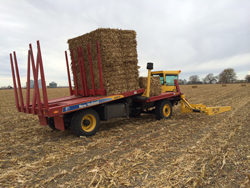 Baling corn stover is part of the next generation of cellulosic ethanol, and two major players in the green fuel and agribusiness markets are moving that process forward. Leifmark, LLC and New Holland Agriculture recently teamed up to test equipment and methods used to gather, bale, and store the corn stover left behind after the grain harvest in two Iowa cornfields.
Baling corn stover is part of the next generation of cellulosic ethanol, and two major players in the green fuel and agribusiness markets are moving that process forward. Leifmark, LLC and New Holland Agriculture recently teamed up to test equipment and methods used to gather, bale, and store the corn stover left behind after the grain harvest in two Iowa cornfields.
Paul Kamp, Leifmark’s Chicago-based partner, coordinated the 520-bale collection. “Using local specialists and best practices, we showed stover harvesting on area farms is very practical. That’s good news for three ethanol producers now considering new businesses making cellulosic ethanol from biomass.”
Developing more efficient methods and equipment brings down the overall cost of stover, says Kamp, whose company markets Inbicon Biomass Refinery technology in North America.
“Couple lower stover prices with a predictable supply chain,” adds Kamp, “and you reduce risk perceptions with biomass. So future plant owners can feel confident putting their capital into cellulosic ethanol projects.”
New Holland Agriculture’s Scott Wangsgard emphasizes that “technology companies like Inbicon have certain specifications for corn stover bales. To meet them, we’ve been designing specialized equipment that also boosts collection efficiencies.”
New Holland used a high-capacity baler and automated bale wagon that picks up, transports, and stacks the 3′ x 4′ x 8′ square bales required for Inbicon’s refining process. Officials say the square bales handle more easily than round ones, store in much less space, and pack tighter so flatbed trucks can haul more tonnage per trip.

